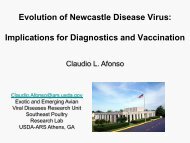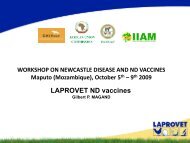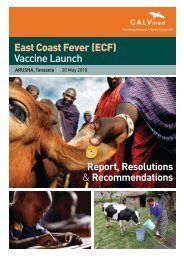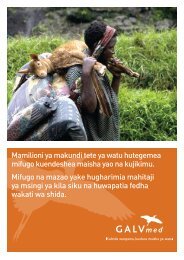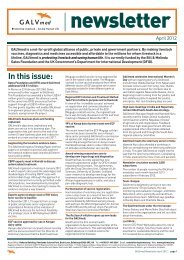A Path to Prosperity New Directions for African Livestock
GALVmed Impetus Strategy Paper
GALVmed Impetus Strategy Paper
- No tags were found...
You also want an ePaper? Increase the reach of your titles
YUMPU automatically turns print PDFs into web optimized ePapers that Google loves.
Annex 1<br />
Overview of Lives<strong>to</strong>ck Development<br />
Players in Africa<br />
The ‘players’ that aim <strong>to</strong> make the lives<strong>to</strong>ck sec<strong>to</strong>r<br />
efficient, sustainable, productive and competitive in<br />
Africa can be placed in<strong>to</strong> four geographical groupings:<br />
national, regional, continental and global. At national<br />
level there is the typical array of government, NGO,<br />
farmer organisations, academia and private sec<strong>to</strong>r<br />
working with variable degrees of coordination and<br />
collaboration depending on his<strong>to</strong>rical, cultural,<br />
political and economic conditions in each country.<br />
The key regional lives<strong>to</strong>ck development bodies are the<br />
Regional Economic Communities (RECs). The RECs<br />
commonly overlap in terms of countries they<br />
represent but eight are recognised by the <strong>African</strong><br />
Union, 8 the continent’s principal political, security and<br />
development body. There are few lives<strong>to</strong>ck businesses<br />
that operate regionally. Some farmers’ organisations<br />
have regional representative bodies, <strong>for</strong> example: the<br />
East <strong>African</strong> Farmers’ Federation – EAFF; Plate<strong>for</strong>me<br />
sous-régionale des organisations paysannes d’Afrique<br />
Centrale – PROPAC; the Network of Farmers’ and<br />
Agricultural Producers’ Organisations of West Africa<br />
(Réseau des organisations paysannes et de<br />
producteurs de l’Afrique de l’Ouest) – ROPPA; plus the<br />
Southern <strong>African</strong> Confederation of Agricultural Unions<br />
– SACAU. However these networks don’t have specific<br />
lives<strong>to</strong>ck components in their structure. The European<br />
Commission and IFAD have long-term initiatives <strong>to</strong><br />
build the institutional capacity of regional farmers’<br />
groups. The EC-funded ‘rein<strong>for</strong>cing veterinary<br />
governance in Africa programme’ initiated in 2011<br />
aims <strong>to</strong> support linkages between these farmers<br />
groups and specific lives<strong>to</strong>ck commodity-based<br />
stakeholder organisations.<br />
Box 8 Regional Farmer Organisation Profiles, SACAU and EAFF<br />
Courtesy of Agriculture and Natural Resources Policy Analysis Network (FANRPAN) 9<br />
The East <strong>African</strong> Farmers’ Federation (EAFF) is a network of farmers' organizations in Eastern Africa,<br />
the equivalent of the Southern <strong>African</strong> Confederation of Agricultural Unions (SACAU) in Southern Africa.<br />
Formed in 2001, the main role of EAFF is <strong>to</strong> voice legitimate concerns and interests of farmers of the<br />
region, with the aim of enhancing regional cohesiveness and improving the socio-economic status of<br />
farmers. The federation endeavours <strong>to</strong> promote the regional integration of farmers, notably through trade,<br />
and in the process, enabling the representation of farmers at regional and international levels. EAFF<br />
membership originates from Burundi, Rwanda, Kenya, Uganda, Democratic Republic of Congo and<br />
Tanzania, and the federation is at an advanced stage of <strong>for</strong>malising membership from Djibouti, Sudan,<br />
Ethiopia and Eritrea as its scope extends <strong>to</strong> the horn of Africa.<br />
SACAU is a non-profit-making farmer organization representing the common interests of national<br />
agricultural unions in the SADC region. SACAU was <strong>for</strong>med in 1992 and mandated <strong>to</strong> represent farmer<br />
organizations in all SADC countries. It has since expanded its membership <strong>to</strong> include 11 SADC<br />
countries 10 . The key interests in the <strong>for</strong>mation of SACAU were marketing and trade, regional development<br />
of the sub-continent, land settlement and environmental issues; security, law and order; labour, research,<br />
extension and training and organizational issues.<br />
SACAU is guided by the following strategic pillars:<br />
> Strengthening the capacity of farmer organizations in the region <strong>to</strong> effectively address the needs<br />
and concerns of their members;<br />
> Af<strong>for</strong>ding a plat<strong>for</strong>m through which farmers interact, meet, receive in<strong>for</strong>mation and exchange views<br />
with various stakeholders on agricultural matters;<br />
> Providing in<strong>for</strong>mation on all farmer organizations in the region through a comprehensive database.<br />
Capacity building of farmer organizations is now on the agenda of SADC and NEPAD, as well as being a<br />
central component in other developmental organizations dealing with agriculture in the region, <strong>for</strong><br />
example IFAD. SACAU is <strong>for</strong>ming strategic alliances <strong>to</strong> ensure that members are provided with stronger<br />
lobbying and negotiating skills.<br />
8 CEN-SAD, COMESA, EAC, ECCAS, ECOWAS, IGAD, SADC, UMA.<br />
9 http://www.fanrpan.org/documents/d00036/<br />
10 Botswana, Lesotho, Madagascar, Malawi, Namibia, Seychelles, South Africa, Swaziland, Tanzania, Zambia, Zimbabwe.<br />
The Impetus Strategy Paper I Page 52



